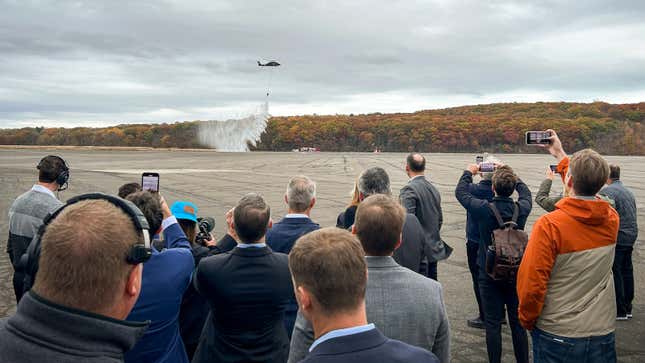Aerial firefighter is the coolest job in the world, if you ask me. These skilled pilots fly ludicrously low to the ground to pick up water and dump it on burning woodland to save communities and wildlife. The livelihoods of those awesome people are under threat, however, as an autonomous Black Hawk helicopter has just shown that robots can do the job just as well.
A test program carried out by American helicopter maker Sikorsky and autonomous flying company Rain has shown off what self-flying helicopters are capable of, reports AutoEvolution. The test, which follows a year-long collaboration between the two companies, saw a Black Hawk helicopter fly for 30 minutes and drop water all without a pilot taking the controls.
The whole showcase was carried out at Sikorsky’s Connecticut base, where the autonomous chopper dropped three buckets of water to put out a propane-fueled fire that measured around 12 inches, as AutoEvolution explains:
The scenario called for the helo to be commanded to take off and head out on its mission using a tablet. The Matrix system guided it while searching for the fire, while the Rain-supplied solution, whose details were not announced, adjusted the flight path to keep it Black Hawk on track, even during crosswinds that reached up to ten knots.
The Black Hawk flew with a Bambi Bucket dangling beneath it, from which to drop water once it located the fire. Three successive water drops were performed, and they helped put out a propane-fueled fire ring 12 inches (30 cm) across that sent six-inch (15 cm) flames into the air.
The entire flight was supervised by Sikorsky safety pilots, but the Black Hawk flew itself for the duration of the mission and up until when it landed.
Watching everything unfold was a crew of onlookers from all kinds of bigwigs in emergency response, including NASA, the Federal Emergency Management Agency, DARPA, the Los Angeles County Fire Department and the Orange County Fire Authority. The assembled masses were apparently impressed with the autonomous chopper, which reportedly adjusting its course on the fly to deal with crosswinds and other changeable conditions, adds Flying Mag.

“It’s humbling to see this impressive machine, and think about the improvement in safety that becomes possible when you’re layering into wildland firefighting an autonomous operation,” said Genevieve Biggs, director of the Gordon and Betty Moore Foundation’s Wildfire Resilience Initiative and Special Projects program, in a statement shared by Sikorsky.
And that’s very true, when you think about it. If the proof of concept can roll out to the field one day, it could mean that fleets of autonomous firefighters are on hand to put out wildfires quickly before they have the chance to spread.
So while a self-flying 737 that fights fires may yet be a distant dream, autonomous helicopters capable of carrying more than 100 gallons of water at a time could be closer than we think.
This does also mean that autonomous helicopters carrying all manner of weaponry are also closer than you might think, though. That’s because the initial tie in with Sikorsky and Rain was all about developing autonomous choppers for the U.S. military, which is a lot less fun than firefighting drones.

